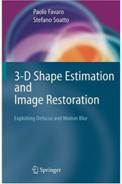|
BOOKSBOOKSBOOKS
3D Shape Estimation and Image Restoration, Exploiting Defocus and Motion Blur
by Paolo Favaro & Stefano Soatto Springer, 2007
Reviewed by: Elisa H. Barney Smith |


|
Click above to go to the publishers web page where there is a description of the book and where you can view the Table of Contents. |
|
Book Reviews Published in the IAPR Newsletter
Applied Combinatorics on Words By M. Lothaire
Human Identification Based on Gait by Nixon, Tan and Chellappar
Mathematics of Digital Images by Stuart Hogan
Advances in Image and Video Segmentation Zhang, Editor
Graph-Theoretic Techniques for Web Content Mining by Schenker, Bunke, Last and Kandel
Handbook of Mathematical Models in Computer Vision by Paragios, Chen, and Faugeras (Editors)
The Geometry of Information Retrieval by van Rijsbergen
Biometric Inverse Problems by Yanushkevich, Stoica, Shmerko and Popel
Correlation Pattern Recognition by Kumar, Mahalanobis, and Juday
Pattern Recognition 3rd Edition by Theodoridis and Koutroumbas
Dictionary of Computer Vision and Image Processing by R.B. Fisher, et. Al
Kernel Methods for Pattern Analysis by Shawe-Taylor and Cristianini
Machine Vision Books
CVonline: an overview
The Guide to Biometrics by Bolle, et al
Pattern Recognition Books Jul. 04 [pdf] |
|
This book is based on the premise that 3D shape and motion information of objects in scenes can be determined from 2D images. While the idea that this is possible by taking binocular or multiple monocular images over a range of locations is intuitive, this book aims to use images taken from a single camera in a single spatial location to accomplish this goal. The authors contend that while research and development puts a lot of effort into developing methods to remove defocus and motion blur artifacts from images because they are treated as nuisances, these same artifacts contain extra information that can be used to extract 3D shape and motion information. The book is structured with a general introduction to vision and vision fields in Chapter 1. Chapter 2 contains summaries of the mathematical models used throughout this book. Future chapters refer back to Chapter 2 often. The third chapter discusses under which conditions one could expect to be able to reconstruct 3D shapes from blurred images and the mathematics that accompany these assumptions. Chapters 4-9 present the 6 specific reconstruction problems this book addresses: ¨ Shape from defocus using least squares ¨ Shape from defocus using minimized I-divergence ¨ Shape from defocus using diffusion process notation ¨ Estimating motion from defocus & motion blur ¨ Estimating motion with multiple moving objects ¨ Shape or image reconstruction in the process of occlusions. Each of these chapters have a similar structure that facilitates reading them. First the mathematics of the applicable model is introduced. This relies heavily on the discussions in Chapters 2 & 3 and makes good references to the appropriate sections. Based on these models the path to derive a solution that will provide the desired image information is described. The details of parts of the derivation are available in an appendix. Next the theory is converted to a concise algorithm. This is then supplemented by Matlab code that implements the algorithm provided in another appendix. Examples running these algorithms are provided first using synthetic images, then with real images. The error for the synthetic images is provided quantitatively and the results for the real images is provided qualitatively through mesh images of the resulting depth maps. The structure of this book makes it easy to follow. Readers with a strong mathematical foundation will be able to get more from this book, but others will still be able to see the gist of how and why the algorithms work to make applying the algorithms and code more than a blind exercise. The authors also use this application in their conclusion to call for returning continuous mathematics to the forefront of the Computer Science curriculum. The weaknesses of this book are in relying on artificially heavily textured objects in the image scenes. They provide justification for this constraint in the foundation chapters, but dont provide adequate discussion on what range of problems with average texture these algorithms are likely to be able to solve. Chapter 1 contains many references to related work in general and the authors do specifically reference other foundational work for areas outside of their scope, however this book would be a better reference for researchers if more references to other work applying these algorithms and variants of them were provided as each topic is introduced and examples for each are presented. Understanding the examples requires not only knowing the method but also knowing the image versus camera geometry and configuration. The discussion of the geometry and physical configuration examples for 3D shape and occlusion is presented well, but the configuration for the motion examples relies heavily on the imagination of the reader. In summary, I think this is a good book if one is interested in a different view on how to extract 3D and motion information from monocular images.
|
